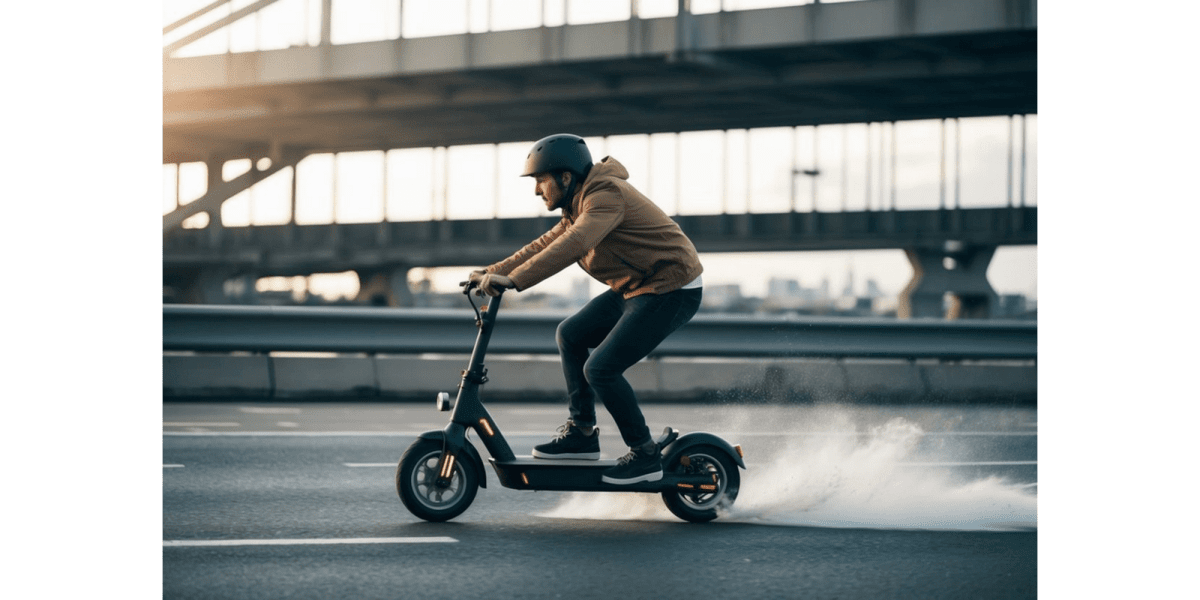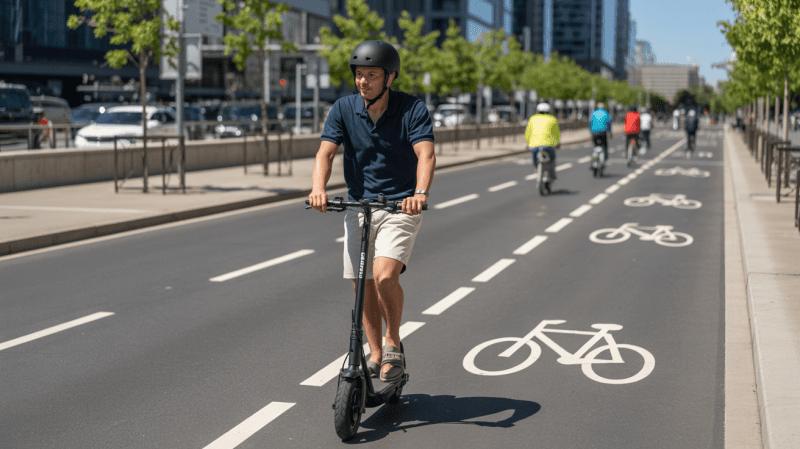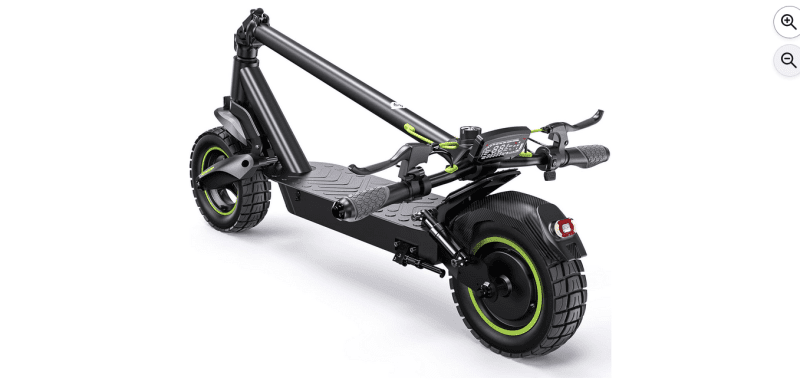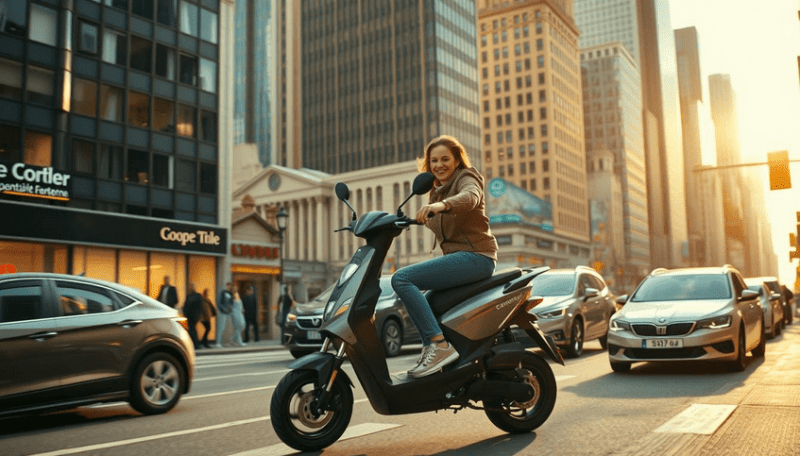Riding an electric scooter can be fun, but windy days can make it tricky. I've learned some tips to help stay balanced when the wind picks up. Leaning into the wind is the key to keeping steady on your scooter.

Holding the handlebars lightly and keeping your arms relaxed helps too. It gives you better control without oversteering. I also make sure to avoid bulky accessories that might catch the wind and throw me off balance.
Regular practice is important for mastering balance on an electric scooter. The more you ride, the better you'll get at handling different conditions, including wind. With these tips and some time on your scooter, you'll be zipping around confidently even on breezy days.
Key Takeaways
- Lean into the wind to keep your balance on an electric scooter
- Hold handlebars lightly and keep arms relaxed for better control
- Practice regularly to improve your balancing skills in various conditions
Understanding the Dynamics of Electric Scooters

Electric scooters have unique handling characteristics. Their balance depends on the rider's position and external forces. Let's look at two key factors that affect stability.
The Importance of Center of Gravity in Balance
The center of gravity is crucial for staying upright on an electric scooter. It's the point where all the weight seems to concentrate. On a scooter, this point changes as I move.
To keep balanced, I need to align my body's center of gravity with the scooter's. I stand with my feet shoulder-width apart. This gives me a stable base. I keep my knees slightly bent to absorb bumps.
Leaning forward or backward shifts the center of gravity. This affects how the scooter moves. When I accelerate, I lean forward a bit. When I brake, I lean back slightly. These small adjustments help me stay in control.
How Wind Affects Stability on an Electric Scooter
Wind can push me and my scooter around, making it harder to balance. Strong gusts can come from any direction. They can even lift the scooter slightly.
To counter wind, I adjust my stance. I lower my body to reduce wind resistance. I grip the handlebars more firmly, but not too tight. This helps me steer and react quickly.
Crosswinds are tricky. They push from the side. I lean into the wind a little to stay upright. I also slow down in windy conditions. This gives me more time to react to sudden gusts.
I watch for objects that might block the wind suddenly. Buildings or large vehicles can create wind tunnels or sudden calm spots. Being ready for these changes helps me ride safely.
Safety First: Essential Gear and Precautions
Staying safe on an electric scooter means using the right gear and taking smart steps. I'll cover what to wear and how to make yourself seen.
Choosing the Right Safety Gear
I always start with a good helmet. It's the most important piece of safety gear for my head. I pick one that fits snugly and meets safety standards. Next, I protect my joints. Elbow pads and knee pads are must-haves. They save my skin if I fall.
I don't forget my hands. Gloves help me grip the handlebars better, even when it's windy. They also protect my palms if I take a spill. For longer rides, I use wrist guards too. They stop my wrists from getting hurt if I land on them.
Visibility and Protective Measures
Being seen is key to staying safe. I wear bright colors during the day. At night, I put on reflective gear. A reflective vest or bands on my arms and legs work well. I also add reflectors to my scooter.
I make sure my scooter has working lights. A white light in front and a red one in back are needed. I use extra clip-on lights for more visibility. When it's dark or foggy, I wear a light-up helmet or headlamp.
I always check the weather before I ride. If it's too windy, I might choose another way to travel. Safety comes first, no matter how much I want to ride my scooter.
Mastering Control and Posture

Good control and posture are key to staying balanced on an electric scooter in windy conditions. I'll cover the best ways to position your body and maintain a stable stance.
Optimal Riding Stance for Balance
I find that a stable riding stance starts with foot placement. I put my feet shoulder-width apart on the scooter deck. This gives me a solid base. I keep my front foot angled slightly forward and my back foot perpendicular to the deck.
I bend my knees a little. This acts like shock absorbers for bumps and gusts of wind. I also engage my core muscles. This helps me stay centered and react quickly to changes.
I keep my weight evenly distributed between both feet. If I need to lean, I do it from my hips while keeping my upper body straight. This helps me maintain control in windy conditions.
Body Positioning Techniques
I hold the handlebars with a light grip. Squeezing too hard can make me tense and less responsive. I keep my arms slightly bent to absorb shocks.
I look ahead, not down at my feet or the scooter. This helps me spot obstacles and stay aware of my surroundings. It also improves my balance.
I try to stay relaxed. Tension in my body can make it harder to adjust to wind gusts. I take deep breaths and keep my shoulders loose.
If a strong wind hits, I lean into it slightly. This counteracts the force and helps me stay upright. I'm always ready to shift my weight as needed to maintain balance.
Effective Riding Techniques in Windy Conditions

Staying balanced on an electric scooter in windy conditions requires some key skills. I'll share tips on foot placement, using your knees for stability, and adjusting your throttle and braking.
Foot Position and Weight Distribution
I've found that proper foot positioning is crucial when riding in wind. I place my front foot at a 45-degree angle near the scooter's front. This gives me better control.
My back foot stays parallel to the deck's edge. This stance helps me shift my weight as needed.
In strong gusts, I lean slightly into the wind. This keeps me stable and stops the scooter from tipping.
I also keep my weight centered over the scooter. If the wind is coming from the left, I shift a bit to the left. This counters the push and keeps me upright.
Utilizing Knees for Enhanced Stability
My knees play a big role in staying steady. I keep them bent, not locked. This acts like shock absorbers against wind.
I use my knees to grip the scooter deck. This gives me a stronger connection to the scooter.
When a strong gust hits, I squeeze the deck with my knees. This helps me stay in control.
I also use my knees to make small balance adjustments. If I feel a wobble, I can quickly shift my weight using my knees.
Throttle and Braking Adjustments
Wind affects my speed, so I adjust my throttle use. In headwinds, I give a bit more power to maintain speed.
With tailwinds, I ease off the throttle. This prevents going too fast and losing control.
I brake earlier in windy conditions. This gives me more time to stop safely.
I use both brakes evenly for the best control. Squeezing too hard on one brake can cause skids in wind.
If I feel unsteady, I slow down. It's better to arrive safely than to rush in dangerous conditions.
Practical Tips for a Smooth and Safe Ride

Mastering electric scooter balance in windy conditions takes practice and skill. I'll share some key tips to help you stay steady and safe.
Navigating Different Terrains
When riding on uneven ground, I keep my knees slightly bent to absorb bumps. On smooth pavement, I stand up straighter for better control. For gravel or dirt paths, I slow down and watch for loose spots.
Wet surfaces need extra caution. I avoid sudden moves and brake gently. Puddles can hide deep holes, so I steer around them when possible.
Going uphill, I lean forward slightly and give the scooter more power. Downhill, I bend my knees more and use the brakes lightly to control speed.
Staying Alert and Reactive
I always scan the road ahead for obstacles or hazards. Quick reactions are key, so I keep my hands ready on the handlebars and brakes.
I watch for cars, bikes, and pedestrians, especially at intersections. Making eye contact with drivers helps ensure they see me.
Wind gusts can push the scooter sideways. I lean into the wind to stay balanced. Sudden calm after a gust can also throw off balance, so I stay ready to adjust.
Advanced Maneuvers and Tricks
With practice, I've learned to hop small curbs safely. I approach at an angle, lift the front wheel, then the back.
For tight turns, I lean my body into the curve while keeping the scooter more upright. This improves grip and stability.
I've mastered a smooth dismount by slowing almost to a stop, then stepping off with my back foot first. For emergencies, I practice quick stops without losing balance.
Maintenance and Pre-Ride Checks
Keeping your electric scooter in good shape is key to staying balanced in windy conditions. I'll cover some important checks and maintenance tasks to keep your ride safe and smooth.
Ensuring Proper Tire Pressure and Condition
I always check my tire pressure before riding. Low pressure makes the scooter less stable, especially in wind. I use a tire gauge to measure and add air if needed.
I look for any cracks, cuts, or wear on the tires. Damaged tires are dangerous and can lead to blowouts.
Proper tire tread is crucial for grip in windy weather. I replace my tires when the tread gets low.
I clean my tires regularly to remove debris that could affect handling. A quick wipe-down helps me spot any issues.
Regular Electric Scooter Maintenance
I inspect my brakes before each ride. I squeeze the levers to check for firmness and responsiveness.
Loose bolts and screws can make my scooter wobbly. I tighten any I find with the right tools.
I keep my battery charged but avoid overcharging. A full battery gives me the power I need to handle windy rides.
I clean and lubricate moving parts like the folding mechanism. This keeps everything working smoothly.
I test all lights and signals to make sure I'm visible to others, especially in poor weather.
Frequently Asked Questions
Riding an electric scooter in windy conditions can be tricky. These common questions address key techniques and safety measures to help you stay balanced and in control.
What techniques can improve my balance on an electric scooter?
I find that keeping my feet shoulder-width apart gives me a stable base. I also bend my knees slightly to lower my center of gravity. This helps me absorb bumps and stay steady.
Looking ahead instead of down at the ground is another useful tip. It helps me anticipate obstacles and maintain better balance.
How can I maintain stability on a scooter during strong winds?
I lean slightly into the wind to counteract its force. This helps me stay upright and prevents tipping.
I also slow down in very windy conditions. Going slower gives me more control and reaction time if a gust hits me.
Are there specific stances or postures that help stay balanced on a scooter?
Yes, I keep my arms relaxed and slightly bent. This lets me steer smoothly without overreacting to small movements.
I also keep my weight centered over the scooter. Avoiding leaning too far forward or back helps me stay balanced.
What factors affect the ease of riding an electric scooter?
The scooter's design plays a big role. Wider decks and larger wheels generally offer more stability.
Road conditions matter too. Smooth, flat surfaces are much easier to ride on than rough or uneven terrain.
My skill level and comfort with the scooter also affects how easy it is to ride. Practice helps a lot.
Why do I struggle with balancing on an electric scooter, and how can I overcome it?
Lack of practice is often the main reason. I found that regular, short practice sessions in a safe area helped me improve quickly.
Starting with a slower speed setting can also help. It gives me time to get used to the feel of balancing before going faster.
What safety measures should be taken when riding an electric scooter in windy conditions?
I always wear a helmet, even in good weather. In windy conditions, it's even more important.
I check the weather forecast before riding. If very strong winds are expected, I might choose a different mode of transport.
I'm extra careful when passing buildings or large vehicles. They can block the wind temporarily, causing sudden changes in wind force.



